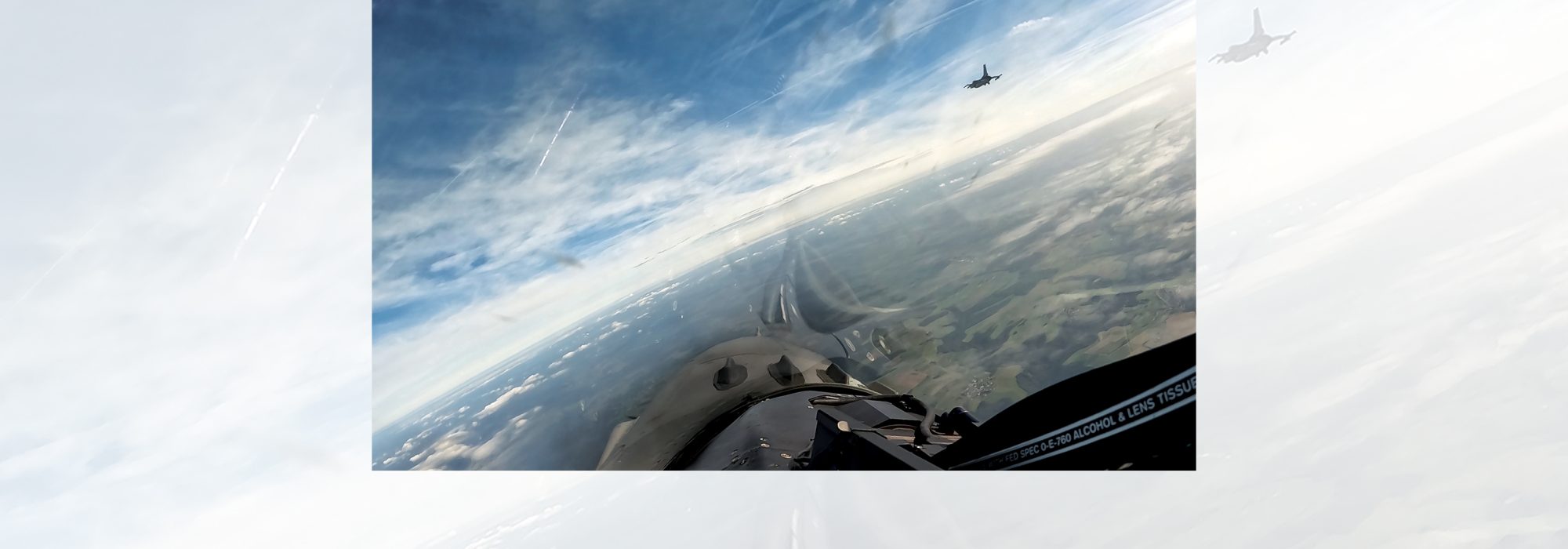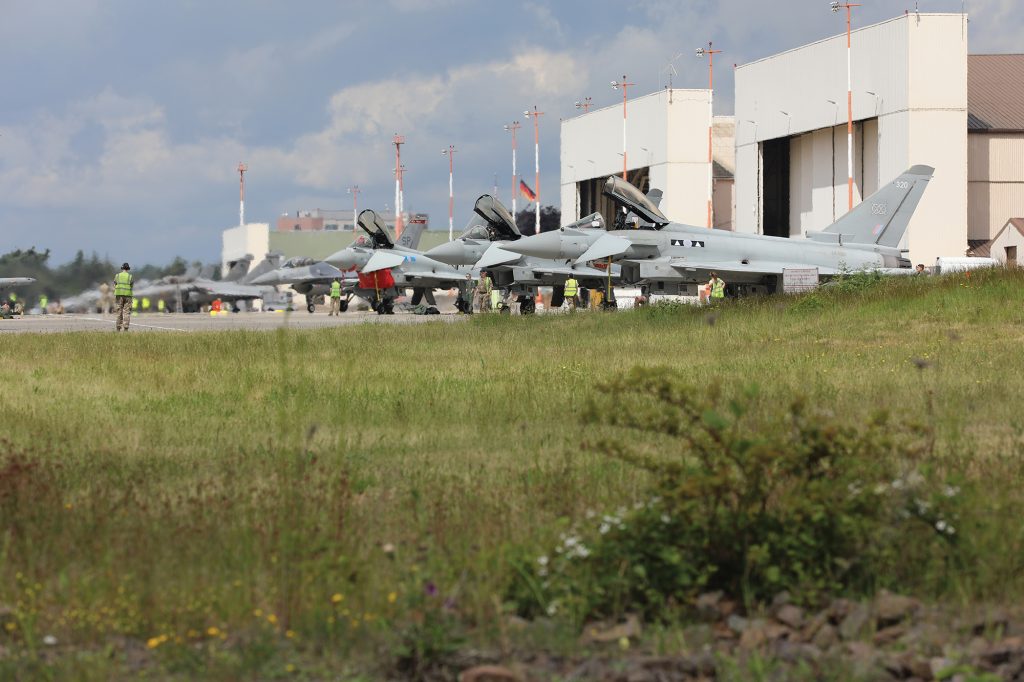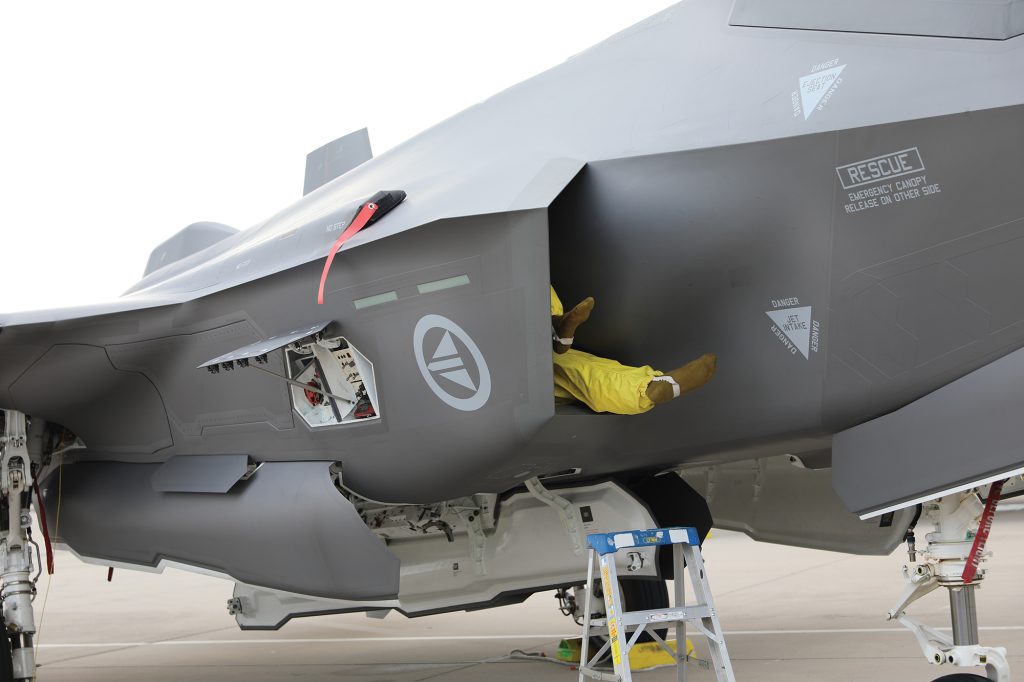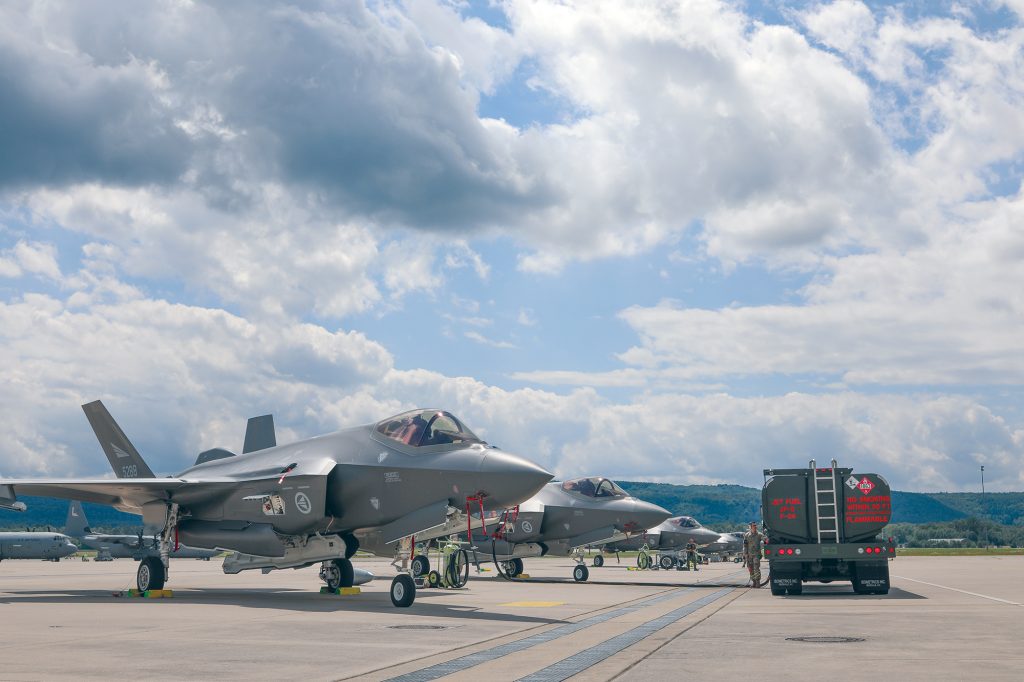Operations in Europe aren’t a summer holiday. The war in Ukraine has turned up the heat.
OVER WESTERN GERMANY
Our F-16 burst through the clouds above Spangdahlem Air Base on a crisp early morning in June, one of several Fighting Falcons from the 480th Fighter Squadron operating as an opposition force for a counter-air exercise.
The 480th is on the front lines of NATO’s eastern flank, with the combat assignment to knock out Russia’s formidable air defenses should a conflict erupt in Europe. Just a couple of weeks earlier, the squadron practiced dispersing to an alternate airfield in case of attack as part of a NATO integrated air and missile defense exercise.
Since Russia’s 2022 invasion of Ukraine, the 480th’s Fighting Falcons have policed NATO airspace, doing their part to ensure the war doesn’t spill over into NATO territory.
We have to be ready for anything that happens. … We have to work with our allies.In order for us to be effective we have to be integrated.”
—Gen. James Hecker, commander of USAFE-AFAFICA and NATO Allied Air Command boss
“This is not a European vacation tour,” said Col. Kevin Crofton, commander of the 52nd Fighter Wing, which includes the 480th. “Now there’s more of a mission involved. Now, there are yellow bands on the missiles on the jets when we’re having live weapons out there at times, as we’re doing these enhanced air policing events. That’s a change.
In preflight briefings, 480th aircrew shout “Magnum”—shorthand for the anti-radiation missiles used to target surface-to-air missile sites.
The 52nd Fighter Wing offers a window into how the U.S. Air Force is answering the challenge in Europe with a fraction of the assets available during the Cold War. Spangdahlem used to house multiple F-16 squadrons; today it has just one squadron of Wild Weasels housed in 1980s-era weather-beaten concrete shelters, slightly overgrown with vegetation.
The Pentagon announced plans to eliminate Spangdahlem’s mission in a bid to remove more forces from Germany, prompted by then-President Donald J. Trump’s dissatisfaction with Germany’s defense spending. The plan was to move the 52nd Fighter Wing to Aviano Air Base, Italy, a decision that would have affected over 5,000 Airmen along with the entire surrounding community. But the decision was reversed the following year when the Biden administration completed its 2021 Global Posture Review.
With the Air Force reorienting for great power competition—specifically the risk of war in the Pacific, Spangdahlem is not the center of activity it once was.
Gen. James B. Hecker, commander of U.S. Air Forces in Europe and Air Forces Africa and the head of NATO Allied Air Command said, “But one thing I have here is a very close-knit alliance that is getting closer and has gotten closer since Feb. 24, 2022.”
That was the day Russia invaded Ukraine and NATO came to terms with the fact it now faces a resurgent Russian threat. The Biden administration calls Russia an “acute threat,” suggesting a possibly near-term concern. Russia’s increasingly close alliances with China and Iran, however, point to an evolving alliance as opposed to separate and distinct threats.
“For 30 years or so, we just didn’t really have to worry about a threat in Europe—being blunt about it,” said Royal Air Force Air Marshal Johnny Stringer, deputy commander of NATO Allied Air Command, in an interview from the command’s headquarters at Ramstein Air Base, Germany. “We sort of came out of the Cold War believing we’ve kind of won it, and conditions were set until further notice.”
Russia’s invasion reset the stage. Although Russia has not proven highly effective in its own use of airpower, its copious use of drones against Ukraine has disrupted the way both sides fight. Some analysts speculate that one-way attack drones and inexpensive quadcopters could dominate future air wars. But, Russia stepped up its use of long-range precision fires, buying ballistic missiles from North Korea and launching glide bombs and missiles into Ukraine from standoff aircraft flying in Russian airspace.
Russia’s resilience in the face of economic sanctions and the ample assistance Russia has gotten from China, including Chinese machine tools and microelectronics, has surprised some in the west.
“Russia remains a capable threat beyond Ukraine,” U.S. Army Gen. Christopher G. Cavoli, commander of U.S. forces in Europe, told Congress in April. Despite major losses in Ukraine and the Black Sea, Moscow has rebuilt its forces and kept its airpower largely intact.
“During this conflict, Russia’s strategic forces, long-range aviation, cyber capabilities, space capabilities, and capabilities in the electromagnetic spectrum have lost no capacity at all,” Cavoli said. “[Its] air force has lost some aircraft, but only about 10 percent of their fleet.”
For the U.S. Air Force in Europe and America’s NATO allies, the Russia-Ukraine conflict has reinforced the West’s need to reprioritize great power competition after 30 years of counterinsurgency operations in the East and operations in the Balkans.
“The Russians invested in electronic warfare and other capabilities to support their activities and seek to nullify our advantage,” said Stringer.
Now NATO’s challenge is finding ways to bust through Russia’s air defenses, gain air superiority at the time and place needed, and counter with anti-air and anti-missile systems of its own. With the alliance expanding to now include 32 members and extending from the Arctic to the Mediterranean, the stakes have grown. Among NATO’s members are three nations that share borders with Russia’s frontier.
“NATO’s membership has gone up from 17 to 32” over the past three decades, Stringer said. “Our landmass is a lot of nations from the Kola Peninsula all the way down to the Turkish-Iranian border. The landmass, let alone the maritime mass—quite a large chunk of the Atlantic we have to worry about for example—has also gone up considerably.”
The addition of Finland and Sweden are the most recent elements of NATO expansion. So now the alliance has more border and airspace to defend, along with “two more nations who now fit into NATO’s integrated air and missile defense system,” he said.
UNITED AND INTEROPERABLE
Interoperability is the key to making such a large and varied alliance work.
“The best way that I can get the bang for the buck is through integration,” Hecker said.
“We have to be ready for anything that happens,” he said. “And in order to do that at scale, we have to work with our allies. In order for us to be effective, we have to be integrated.”
That’s happening rapidly. Allied air forces are modernizing, ditching legacy jets in favor of fifth-generation F-35 Lightning II fighters. Despite production and technical issues, the Lockheed Martin jets are a hot commodity, the only exportable fifth-generation jet in production. After Russia invaded Ukraine, Germany wanted in as well, with one German official describing the purchase enabling Germany to join the family of F-35 partner nations.
A common airframe with a common operating picture will test just how well partners can integrate in practice. The U.S. and European air forces want more than interoperability. They want to be able to service each other’s aircraft. Most NATO countries are now signed up for the alliance’s aircraft cross-servicing agreement, a previously dormant program that was reactivated in 2018.
In April, U.S. F-35s from RAF Lakenheath, U.K., practiced that level of trust, landing in Norway, where Norwegian maintainers serviced their jets. Then in June, at a one-on-one fighter competition at Ramstein, American maintainers serviced Norwegian F-35s.
NATO partners want to share F-35 mission data files, which collect data from the aircraft’s sensors that identifies potential threats, such as air defenses, enemy aircraft, geography, and more. Overcoming security barriers remains a challenge—even in NATO.
“It’s bureaucratic for a reason because the mission data files are extraordinarily important to the F-35,” said Maj. Gen. Paul D. Moga, commander of the 3rd Air Force, the umbrella command over USAFE-AFA’s wings. “A lot of it is intelligence and information-sharing barriers that we need to get past.”
What the F-35 brings to the fight is more than meets the eye, he said. “They talk about survivability because of stealth, primarily lethality, because of systems and avionics and integration thereof, and advanced weapons,” Moga said. Yet “the F-35 is very much also about interoperability. And that’s just not interoperability when you’re flying in formation on a mission together.”
Ultimately, more than 600 F-35s will be operating in Europe in the 2030s—and only about 10 percent will be American.
ACE OPERATIONS
As the U.S. and its allies are doing in the Pacific, Hecker said NATO allies are implementing the Air Force’s Agile Combat Employment (ACE), in which Airmen would disperse in time of conflict to multiple smaller air bases, complicating targeting for adversaries. At this exercise in May, Airmen from the 52nd Fighter Wing dispersed as if Spangdahlem was under attack, relocating to a makeshift tent city at NATO’s Geilenkirchen Air Base in Germany.
“It’s almost back to the future,” Hecker said. “If you go back 35 years ago, a lot of the ACE concepts were alive and well, here in Europe with a smaller alliance at the time. But it’s still a big alliance, where you could take off with any aircraft and land in pretty much any of the NATO countries, be able to get gas, fill up your tires, and in some cases, get munitions and those kinds of things. And that’s what we’re building to try to get back to that construct.”
Improved air base defense and air and missile defense is a top USAFE priority, Hecker said. He has a team of experts devoted to those issues at his headquarters, but he noted that no active defense is bulletproof.
“We will never have enough base defense assets that I can protect every single base 24/7 here,” Hecker said. “It only works to move the assets inside of their targeting cycle. We’ve got to make sure that we move them quite often. And then, you know, with everything coming in, something’s going to get through eventually.
So you have to make sure you have an adequate rapid runway repair model so that you can repair airfields when you do have a leaker that gets through. And then you have to do some passive things, as well; decoys and those kinds of things used to keep them off balance, so they don’t know exactly where everything is all the time. There’s a lot that goes into it.”
Spreading the footprint out more permanently requires more legwork. On Poland’s eastern flank, the 52nd Operations Group’s Detachment 1 is headquartered at Lask Air Base, a small team that it coordinates and supports fighters, tankers, and airlift operations, in and out of the country.
The air operations across Europe and Africa are monitored at the 603rd Air Operations Center at Ramstein, where the commander can watch the action from behind a mirrored glass wall, on a raised area that looks like the bridge of a futuristic spacecraft. USAFE conducts so many exercises that its two massive screens are often divided between one depicting real-world events while the other is used to control the exercise. To protect classified information, Airmen displayed open-source flight tracking websites on the large screens during this reporter’s visit—providing rare insight into its nerve center and how densely populated the airspace over Europe is.
Developing the capacity to work from common bases is also part of NATO’s long-term vision. “We do not do that often enough,” said Luftwaffe Col. Michael Trautermann, the senior German national representative to NATO Allied Air Command. “These are things that need to be regained for NATO as an alliance to be able to be successful.”
During a one-on-one fighter competition at Ramstein Air Base in early June, 37 NATO fighters from nine countries flew onto the base, where Ramstein personnel helped marshal aircraft, pumped them full of 160,000 gallons of jet fuel, and kept everyone safe in the skies through its air traffic control. The competition practiced the Air Force’s push toward building Airmen who can conduct a variety of tasks to complete a mission.
“Rapid launch and recovery, ground ops … they did all those skill sets that we’re trying to exercise,” said Maj. Gen. Christopher F. Yancy, mobilization assistant to the commander of U.S. Air Forces Europe-Air Forces Africa. “They’re used to working on heavies. They hadn’t worked on fighters.”
“Virtually everyone is hungry for interaction with bombers,” said Maj. Gen. Jason R. Armagost, who runs America’s bomber force as commander of the 8th Air Force. “Say you’re a country in Central Europe, and you don’t have tankers, you don’t have bombers. Nobody has bombers but us. That’s an important thing to remember. But when you integrate in a way that brings a joint and complex force presentation, you’ve taken your sovereign airpower, which is defense of your homeland or defense of NATO, and you’ve now aggregated to the ability to project power, essentially through integration.”
For the Airmen of U.S. Air Force in Europe and NATO Allied Air Command, whether pilots or commanders or even political leaders, the new reality is that only by working together will they be able to provide for the common defense.
“If you’re fighting with someone, it helps to know them,” said Norwegian Air Force Col. Martin Tesli, wing commander of Ørland Air Base, Norway, the country’s main F-35 base.







